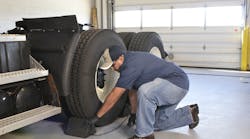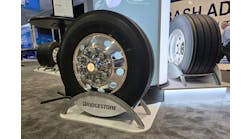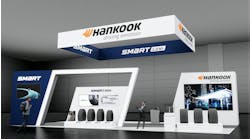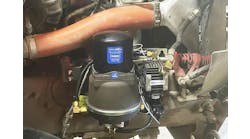Fleet shares implementation of new SOP to mitigate wheel-offs
The term “wheel-off” refers to an incident in which a wheel dismounts from a vehicle while it is in operation. This can be caused through loose lug nuts, bearing failure at the spindle, improper torque on the lug nuts, rusted or damaged lug nuts, threads or studs, or improper installation and inspection procedures. Wheel-offs are extremely dangerous and have resulted in devastating accidents, damages, and loss. To help mitigate wheel-off instances, it is imperative to follow standard operating procedures (SOPs) when installing and servicing commercial vehicle wheels.
Updates to install and inspection
Dan Flanagan, vice president of maintenance for Bulkmatic Transport, has taken the initiative to go above and beyond the Technology and Maintenance Council’s recommended SOP and implemented a new installation and inspection procedure with his technicians in order to minimize the risk of wheel-offs and help ensure the safety of Bulkmatic’s drivers and the public motorists they share the road with. Bulkmatic, headquartered in Griffith, IN, has 55 terminal locations across North America, more than 550 tractors, and over 1,500 dry bulk trailers.
Bulkmatic, like many fleets, has had instances of loose wheels and even wheel-offs. Flanagan spoke to the struggle of ensuring the company’s technicians and vendors were doing their part in assuring the wheels and spindle nuts were properly installed and torqued each and every time a wheel was serviced. Technicians can face many distractions in a shop from incoming and outgoing drivers, dispatch, shop managers and the workload of simultaneous services. Whatever the case may be, there is opportunity for a technician to lose track of their wheel service and miss important steps and procedures. Flanagan wanted to eliminate this risk and has brought forth his personalized SOP for wheel service.
Flanagan served in the U.S. Marine Corps for 21 years, serving as a crew member involved in the repair process of jet fighter aircraft. He spoke to the SOP of aircraft repair and how it has influenced the SOP he has implemented for Bulkmatic’s wheel servicing. “When our aircraft were repaired, it was required that a collateral duty inspector (CDI) inspect the repair. If the repair involved a flight control item, a quality assurance representative (QAR) would observe and inspect the repair. We are using a similar process, requiring a ‘certified observer’ to witness the critical process of the installation of the spindle nut and wheel lug nuts. The QAR level [of service inspection] is the level we need to be [at] with wheel and hub installation,” said Flanagan.
Flanagan’s SOP is filling in the gaps that standard SOPs may overlook. A second pair of trained and certified eyes is verifying that the process is being performed properly. The “certified observer” – who could be another technician in the shop, a dispatcher, or even a terminal manager – receives the same training and certifications as the technicians completing the service in order to thoroughly ensure that the verification is sufficient. The SOP requires that a certified observer is present throughout the process of spindle nut and wheel installations. If a certified observer is unavailable, the service is halted and only continues when a certified observer is able to verify the installation process. Flanagan noted that this piece of the procedure has caused some delays, but he values the safety insurances over the loss in uptime. The SOP also calls for a torque check of every wheel lug nut during each preventative maintenance (PM) procedure, which is scheduled in 60-day intervals for Bulkmatic.
This SOP goes beyond Bulkmatic’s own vehicles and technicians. If a vendor installs wheels on Bulkmatic property, they too are subject to the SOP and must have a certified observer witness the lug nut torqueing process, as well as sign off on the service procedures. The SOP also calls for wheel torque measurements to be entered into Bulkmatic’s maintenance system in order to verify over-the-road installs upon the vehicle’s return to a Bulkmatic location.
Feedback from implementation of new SOPs
Flanagan initiated the new process in March of this year after having each technician individually trained and sign off on the new SOP. One of the challenges Flanagan has faced with the implementation of this new SOP was the increased time it takes to complete the procedure. To address this, technicians requested the standard repair times (SRT) be adjusted to account for the changes. Bulkmatic adjusted its SRT and has fully implemented their procedures. Bulkmatic also had some push back from certain vendors, who are now required to uphold the new SOP on Bulkmatic property. However, Flanagan and Bulkmatic were also applauded by other vendors for taking a major step forward in promoting safety.
With the new process in place, mis-torqued lug nuts have been caught and rectified before any wheel-off instances were able to take place. Flanagan claims that of the vehicles that have been checked under the new SOP at the time of PM, only lug nuts installed by one of the company’s vendors have been mis-torqued. The new SOP seems to be working, as vehicles serviced in-house and on company property have been wheel-off incident free since the new procedures have been in place. “Our ultimate goal is to never have a wheel prematurely leave a vehicle,” said Flanagan. “We will continue to test and tweak our SOPs to ensure we stay on top of any other means to possibly make our equipment the safest on the road [in order] to ensure public safety."




